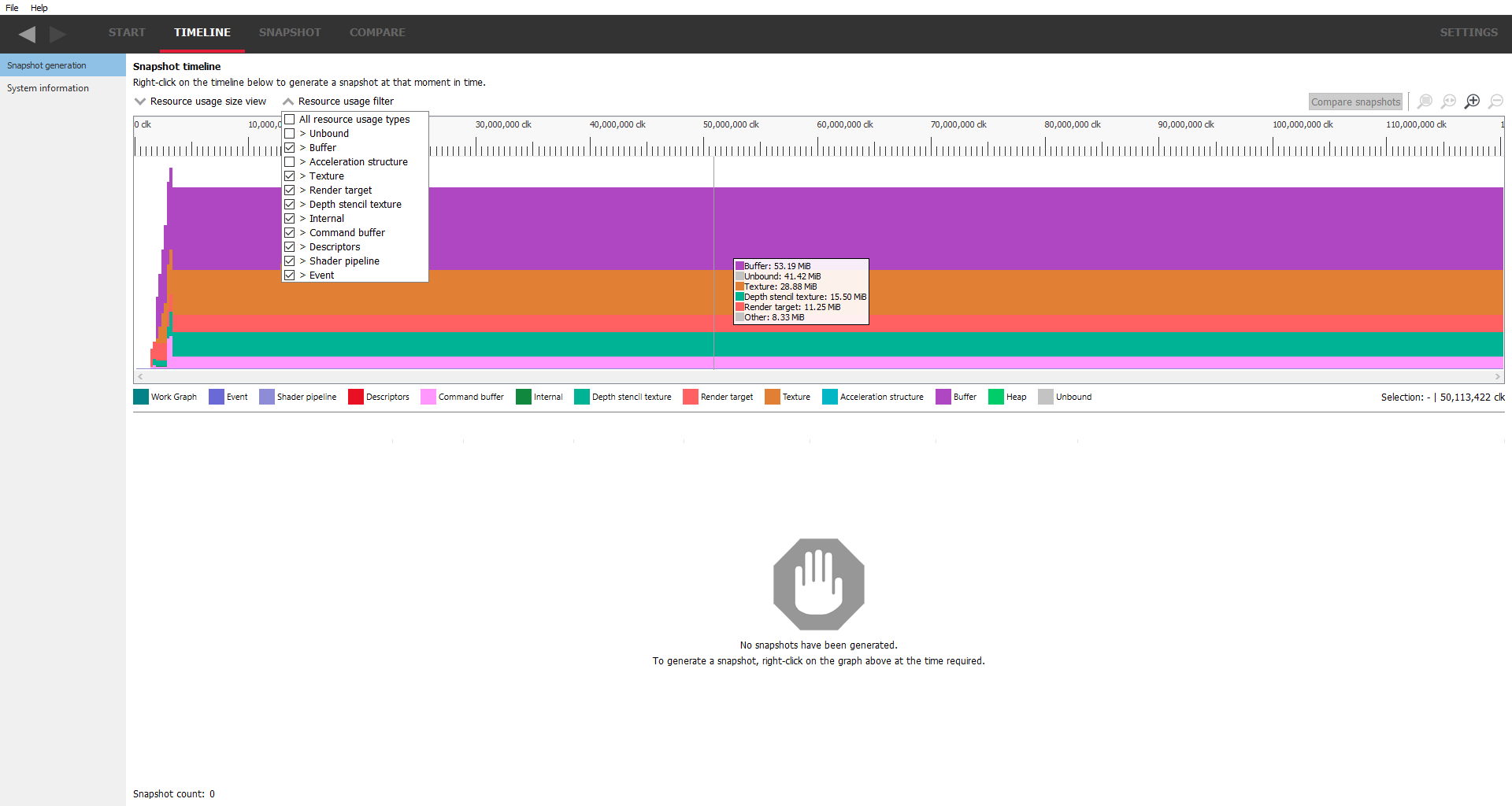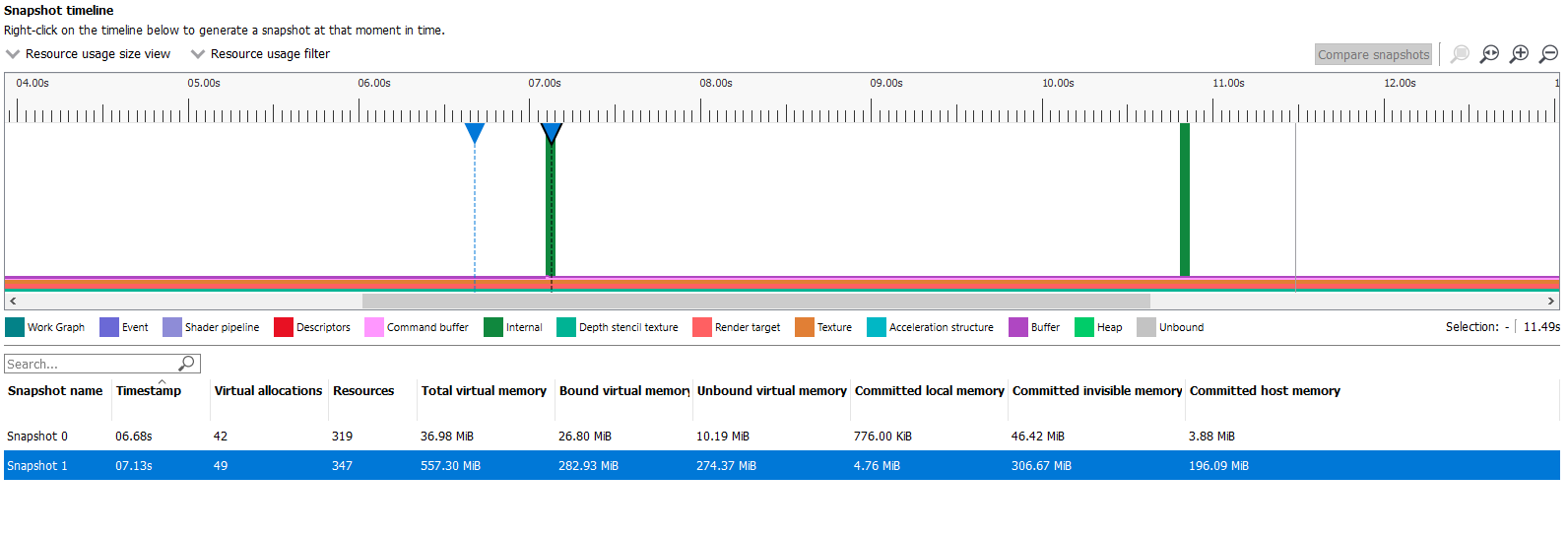The Timeline windows
The timeline tab shows the overview of the trace and the system.
Snapshot generation
The Snapshot generation view will be the first view shown when a memory trace file has loaded. It will show a graphical representation of the memory usage over time for a number of processes running on the system, including the application started by the user. Currently only the user’s process is available.

RMV uses the concept of snapshots. A snapshot is the memory state at a particular moment in time. Using multiple snapshots, it is possible to visualize how memory is being used by an application over time. It is also possible to compare snapshots to check to see if memory is being release or whether there are memory leaks.
Snapshots will be displayed in a table below the timeline graph. If there are no snapshots contained in the trace, the area under the timeline graph will indicate that there is nothing to show and offer some guidance of what may be required, as shown above. There are other instances in the tool showing similar displays, such as a resource table being empty if the selected allocation contains no resources, or if a resource type has no additional properties to show.
If snapshots were taken while recording, they will be shown as markers on the graph and in the table below the graph.

Timeline graph
The Timeline graph displays a visual representation of memory related events contained in the trace that occurred over a period of time along the horizontal axis. There are three viewing modes:
- Virtual memory heap
- Resource usage count
- Resource usage size
The viewing mode can be changed by selecting from the combo box above the top-left of the timeline. Note that with previous releases of RMV, the default Timeline view was “Resource usage size.” The default mode is now “Virtual memory heap.”
A color legend below the timeline will indicate what resources are represented by the colors in the timeline.
When the mouse is over the timeline, the tooltip help will show information about the memory allocated at the time corresponding to the mouse position. The time can be seen from the ruler above the graph. The most abundant resources are listed and the rest are combined in the last entry as “Other.”
Starting with release 1.8, RMV takes overlapping resources (i.e., aliased resources) into account when calculating usage type sizes on the timeline. When RMV detects multiple resources that are bound to sections of virtual memory that overlap, the usage size is attributed to the resource with the highest importance. This is reflected in the height of bars on the “Resource usage size” timeline and also, the values displayed on the tooltip when the mouse hovers over a point on the timeline graph. The priority of resource importance’s matches the order of resource types displayed on the legend below the “Resource usage size” timeline graph. Resource types towards the left side of the legend have higher priority and those towards the right have lower priority. In past releases of RMV, the legend order was reversed. The order of the stacked usage types on the timeline graph in prior releases was also reversed.
Calculating usage sizes in this way gives a more accurate assessment of memory utilization and prevents memory from being counted multiple times. For a deeper explanation of how memory size is calculated for aliased resources, please see the Resource overview section in this document.
The additional usage size calculations required to take aliased resources into account requires considerably more time to process. For this reason, a Cancel button has been added below the loading animation while the “Resource usage size” timeline is being generated. At any time during this processing, the user may click the Cancel button to revert to the previously displayed timeline mode.

As shown in the screenshot above, the Resource usage size timeline view provides the option of showing or hiding the various usage types. Click the “Resource usage filter” drop down combo box to view a list of checkboxes. This can be helpful when viewing some resource usage sizes that have small values relative to other usage sizes on the graph. The “Resource usage filter” is available in the Resource usage count timeline view as well.
Zoom controls
Zoom controls are provided for adjusting the time scale that is viewable on screen and are displayed in the top right of the timeline pane. These are:
![]()
Zoom to selection
When Zoom to selection is clicked, the zoom level is increased to a selected region or selected event. A selection region is set by holding down the left mouse button while the mouse is on the graph and dragging the mouse either left or right. A colored overlay will highlight the selected region on the graph. For graphs that support it, an event may be selected by clicking on it with the mouse (either the left or right button). Zoom to selection can also be activated by right clicking on a selection on the graph and choosing the Zoom to selection context menu option. Zooming to a selected event can be accomplished by simply double clicking the event. Pressing the Z shortcut key while holding down the CTRL key activates Zoom to selection as well.
![]()
Zoom reset
When Zoom reset is clicked, the zoom level is returned to the original level to reveal the entire time span on the graph. The zoom level can also be reset using the H shortcut key.
![]()
Zoom in
Increases the zoom level incrementally to display a shorter time span on the graph. The zoom level is increased each time this icon is clicked until the maximum zoom level is reached. Alternatively, holding down the CTRL key and scrolling the mouse wheel up while the mouse pointer is over the graph will also zoom in for a more detailed view. Zooming in can be activated with the A shortcut key. To zoom in quickly at a 10x rate, press the S shortcut key.
![]()
Zoom out
Decreases the zoom level incrementally to display a longer time span on the graph. The zoom level is decreased each time this icon is clicked until the minimum zoom level is reached (i.e. the full available time region). Alternatively, holding down the CTRL key and scrolling the mouse wheel down while the mouse pointer is over the graph will also zoom in for more detailed view. Zooming out can be activated with the Z shortcut key. To zoom out quickly at a 10x rate, press the X shortcut key.
Zoom panning
When zoomed in on a graph region, the view can be shifted left or right by using the horizontal scroll bar. The view can also be scrolled by dragging the mouse left or right while holding down the spacebar and the left mouse button. Left and right arrow keys can be used to scroll as well.
Taking snapshots
Snapshots can be taken by right-clicking anywhere on the memory graph. This will bring up a context menu. Clicking on the context menu option “Add snapshot ..” will take a snapshot and add it to the graph and to the snapshot table below the graph. Notice that only the snapshot name is shown in the table; the other table entries will be created when the snapshot is viewed.
Snapshots can be selected by clicking on them in the table. Multiple snapshots can be selected by holding down the Shift key (selects a range) or Ctrl key (adds a snapshot to the selection group).
Right-clicking on snapshots in the table brings up a context menu. Different menu options are available depending on the number of snapshots selected.
-
Single snapshot selected: Rename snapshot, Delete snapshot and Delete all snapshots
-
Two snapshots selected: Compare snapshots and Delete snapshots*
-
Three or more snapshots selected: Delete snapshots
Snapshots can be renamed using any printable ASCII character, including spaces. Snapshot names are limited to 32 characters. Snapshots are saved back to the trace file so they can be viewed at a later date.
Two or more snapshots can be selected in the table by holding down the shift key to select a range of snapshots or pressing Ctrl to select individual snapshots. If two snapshots are selected, right-clicking on the table while holding down the Ctrl key will display a context menu to allow them to be compared. Alternatively, the Compare snapshots button in the top right will become active. Clicking on either will jump to the Snapshot delta pane in the COMPARE tab. Alternatively, selecting two snapshots in the table and clicking on the COMPARE tab will do the same thing. The snapshots will be compared as base snapshot vs diff snapshot, where the base snapshot is the last (or highlighted) snapshot that was selected, and the diff snapshot is the first snapshot selected. If no snapshot is highlighted or the last snapshot was deselected (in the case where three snapshots are selected and one of those is deselected), the snapshots will be compared in the order they appear in the table.
Clicking on the SNAPSHOT tab with a snapshot selected, or double-clicking on a snapshot on the table or on the graph will jump to the Heap overview pane on the SNAPSHOT. This process will generate the snapshot data at the required time and returning back to the Snapshot generation will now show the table fully populated for the selected snapshot.
RGP Interop
It is possible to take RGP profiles at the same time as capturing an RMV trace. One thing to bear in mind is that at the point when an RGP profile is taken, the driver will allocate video memory for the RGP profile data. This can be seen in the RMV memory trace as spikes on the timeline corresponding to a resource type of ‘internal’, as seen below.

System information
This pane will show some of the parameters of the video hardware on which the memory trace was taken, showing such things as the name of the video card and the memory bandwidth. In addition, if any Driver experiments are included when the trace was captured, they will be displayed here under the section labeled Driver experiments. Hovering over a driver experiment name or value with the mouse pointer displays a tooltip describing that item.
